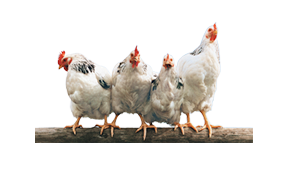Birdology: Adventures With A Pack of Hens, A Peck of Pigeons, Cantankerous Crows, Fierce Falcons, Hip Hop Parrots, Baby Hummingbirds, and One Murderously Big Living Dinosaur
Simon & Schuster, ISBN 978-1416569848
Introduction
I have waited a long time to write this book.
Ever since I was privileged to live among and study wild emus in South Australia in 1984, I have wanted to write a book about birds. Though I have written elsewhere about those emus, I never got around to a whole book about birds, mostly because mammals kept jumping the line: Chimps, gorillas and orangutans. Man-eating tigers. Amazon river dolphins. Snow Leopards. Tree Kangaroos. Our wonderful pig, Christopher Hogwood. Putting off this book was not intentional, but perhaps fortunate. It is easier to understand our fellow mammals; birds are more distant and enigmatic. It has taken me all this time to even begin to learn how to probe their mysteries.
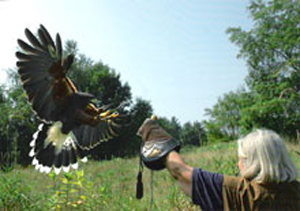
Birds have been trying to educate me since I was a child. I have always loved watching and reading about and learning from them. But even more importantly, birds always come into my life at critical moments to enrich my spirit and enlarge my heart.
The first male ever to court me —I was only a child but I loved him deeply—was a bird. I was seven. His name was Jerry. He was a green parakeet who came home with me from a dime store. And although I was delighted when he first agreed to perch on my hand and thrilled when he would finally fly to me, I was most honored when he threw up on my finger. Even though I had never seen any other creature do this in quite the same way, I understood what was happening: he was feeding me. This was a mark of deep trust and affection, and he would do this with only me. He had taken me as his mate.
I was entranced and honored by everything Jerry did. I loved the way he used his curved beak to hull his round millet seeds. He’d pierce the husk with his lower mandible and peel the outer husk away by forcing the seed against his ridged palate and twirling it with his strong, muscular tongue. Jerry was thrillingly different from everyone else I had known. Even his digestive system was a radical departure from those of mammals, as I could clearly see from his droppings, which appeared from a single opening and incorporated both waste products in one neat, little, two-colored package. And of course I loved that Jerry could fly. I let him do so often, to my mother’s dismay. He liked to perch on the crystal chandelier over her prized mahogany dining room table, with predictable consequences.
People used to ask me if I wanted to teach Jerry to talk. I did not. I already had friends who talked. I wanted him to teach me what he knew, for I realized that he was the master and I the student. Among the many things he showed me: birds stir our souls in ways that change our lives.
The ancients knew this well. Images of birds adorn the walls of the caves of Lascaux, accompanying prehistoric humans on the hunt. It’s easy to imagine why people carved pictures of birds on tombs as early as 2600 BC. Birds fly through the air, the element of our breath; they symbolize the soul. From Sufi poetry to Native American myths, from Egyptian tombs to Christian tapestries, birds beguile us. With their beauty, their songs, their flight, and their very strangeness, birds stir our deepest psychic strivings. Even the commonest of birds (remember Jonathan Livingston Seagull?) wield the power to thrill and inspire.
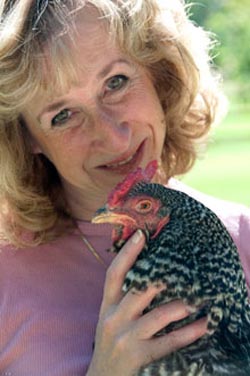
No wonder bird-watching is the fastest-growing of all outdoor activities in the United States, and one of the most popular hobbies the world around. Happily, there are many hundreds of excellent books in print on bird-watching and classification. This book is not among them. Instead, these pages address a dilemma about which British author Tim Dee writes in his book, A Year on the Wing. “We seek the truth of birds though collection and classification,” he writes. But the truth of birds eludes us. Of a woodcock he recorded at age thirteen, he writes, “I was sure of our identification… but it offered so little of itself that I felt I had been simultaneously shown the bird and excluded from it.” He calls this “the defining condition of bird-watching.” We can know a bird’s name; we can identify it and by its sighting add it to our “life list”; but still, the essence of the bird flies away.
Even though birds are all around us, most of them are strangers. We don’t know them as individuals. We know very little of what it might be like to be a bird. If we did, we would be awestruck. That is the purpose of this book: to restore both our awe and our connection to these winged aliens who live among us.
Birds are the only wild animals most people see every day. No matter where we live, birds live with us. Too many of us take them for granted. We don’t appreciate how very strange they are, how different. We don’t realize what otherworldly creatures birds are.
Their hearts look like those of crocodiles. They are covered with modified scales—we call them feathers. Their bones are hollow, permeated with extensive air sacs. They have no hands. They give birth to eggs. No other scientific classification of living creature we commonly see is so different from us as is Class Aves. We don’t even think of birds as “animals” (although they are—and humans, as well, of course). We consider “animals” to be our fellow mammals, with whom our kinship is obvious. It’s easy to see a kindred soul when you look in the eyes of a chimp, for instance. They share more than ninety-eight percent of our DNA. You can get a blood transfusion from a chimp. We shared a common ancestor with chimps as recently as five million years ago. But actually, all mammals now living (except for the pouched marsupials like kangaroos and the egg-laying platypus and echidna) share at least ninety percent of their genetic material with humans. We shared a common ancestor with even the most distant of our fellow placental mammals as recently as 100 million years ago. The last ancestor we shared with the birds, however, traces back 220-240 million years ago.
A bird is as distant from us as a dinosaur. But unlike the extinct monsters of the Jurassic and Cretaceous, birds are today everywhere among us—on our sidewalks, at our birdfeeders, on our dinner plates. Yet despite our disparate evolutionary paths, scientists are now beginning to reveal the extent to which birds’ emotional and intellectual abilities are remarkably like ours.
To understand birds is to appreciate at once their fundamental strangeness and sameness. What makes a bird a bird? To explore this question, in these pages I share my adventures with seven different bird species. Each chapter explores a different aspect of avian essence. Here are seven essential truths about birds.
In my opinion, the first thing you need to know about birds is that Birds Are Individuals. That’s why I begin this book with The Ladies, my flock of emotional, intelligent and highly individualistic hens, who come when called, love to visit the neighbors, and befriend and feud with fellow chickens. Although a flock of hens is all about community, each chicken is quite distinctive, and the personality of each individual is extremely important to the flock dynamic. People who don’t know chickens are always astonished to learn this; but when you are in the company of birds, you must be prepared to be surprised.
A second fundamental truth of birds lends a title to the second chapter: Birds Are Dinosaurs. That may be difficult to see when you’re watching a fluffy chickadee at the feeder; but it is abundantly clear when you are crashing through the rainforest of Queensland, Australia, pursuing a 150-pound cassowary, a bird as tall as a man crowned with a helmet of bone on its head and a killer claw on each foot. Following these birds’ Tyrannosaur-like footprints, I traveled back in time, to an era of wondrous transformation.
The dinosaurian lineage that became the birds left the Earth for the skies. And in doing this, they utterly reshaped their bodies inside and out. We mammals are made mainly of heavy fluids; but as I have titled another chapter, Birds Are Made of Air. Their bones are hollow; their feathers weigh more than the skeleton. Their bodies are full of air sacs; their feathers, also hollow-shafted, are sculpted to capture and move air. Birds are essentially feather-fringed bubbles—a fact frustratingly poignant to bird rehabilitators, whose Herculean task it is to a nurse back to health, or raise to adulthood, beings whose essential fragility gives them the power to conquer the sky. It was my great luck to apprentice myself to a woman whose job was yet more difficult than that of most bird rehabilitators: Brenda Sherburne’s specialty is raising orphaned baby hummingbirds, who hatch from eggs the size of Navy beans and are born the size of bumblebees. They are air wrapped in light—the lightest birds in the sky.
What else must we know before we begin to understand what makes a bird a bird? Birds’ wildness, for one. Even a pet parakeet, even a barnyard chicken, is wild in a way that most mammals are not. To explore this, I embarked on a study of falconry, for the hawks and falcons exhibit a genius for instinct that showcases the brilliance of all birds’ wildness.
Birds are able to apprehend the world in ways that we cannot. They can see polarized and ultraviolet light. They experience colors we can never know. They sense the Earth’s magnetic field, navigate using subtle changes in odor and barometric pressure. They imbibe realities of this world that we cannot fathom, and use it to circumnavigate the globe. We are only now starting to understand how birds accomplish these extraordinary feats, by way of one of our most ordinary and unappreciated birds, the pigeon—the hero of yet another chapter.
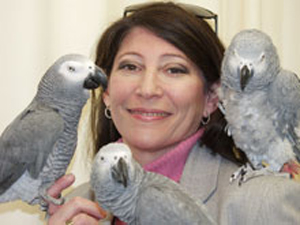
Though gifted with instincts and senses that we lack, birds’ intellectual capacities are shockingly similar to our own. Some birds appreciate human art to the extent that they can learn to tell the difference between the paintings of Monet and those of Manet. Some birds love to dance—and in the course of researching this book, I got to dance with one of them. Birds’ capacity for song is of course so legendary that many cultures tell us the birds taught music to humans. There are birds who can even speak to us meaningfully in our own language—something that, many scientists believe, even our close hominid cousins, the Neanderthals, probably could not do. But, as I title another chapter, Birds Can Talk. In these pages, I relate some of what they tell us.
And finally, to apprehend the truth of birds, we need to appreciate birds’ ubiquity. The final chapter, Birds Are Everywhere, takes us to a winter crow roost of tens of thousands of birds, a congregation that had been traditionally based in the countryside but, like the majority of the world’s population of humans, has moved into the city. How do the city’s people react to their new urban neighbors? And what does this say about the future of humans and birds living together on this sweet, green Earth?
Just as I was beginning to research this book, my friend Gretchen Vogel called me with an unusual suggestion: that we should go to church together. I was raised Methodist; she was raised Catholic; but the church she had in mind was The First Universalist Church in West Chesterfield, New Hampshire, about an hour’s drive from my house and twenty minutes from hers. She had read a notice in our local paper about that week’s sermon. The title was “Birdology.” How could I resist?
The small church, built in 1830, had no cross in the front, and the ceiling inside was painted a light blue, like the sky. Gretchen and I joined six other people in the congregation that Sunday. Presiding was a visiting pastor, Reverend Elaine Bomford.
A smiling, articulate woman in her 50s, the pastor greeted us with the confession that “Birdology” was a word she had made up. She did so to describe the person who—unlike the ornithologist, with his fancy university degree—hasn’t completed a formal course of avian study. To be a birdologist, she said, “you just have to appreciate birds, and be intentional about appreciating birds in some way.” We could all be birdologists, she said—and we should be. For watching birds, she told us, “strengthens our souls.”
A birdologist, she explained, “experiences the divinity of creation revealed in the birds.”
That pretty much describes what I have always felt when I see a bird—any bird. The ancients believed that birds could bring us messages from the gods: whether a battle would be won or lost, or if plenty or famine would befall the city. Birds do bring us messages from the divine, but not necessarily those the ancients sought. Because of birds’ very different lineage; because they are made of different stuff than we; because of the powers that birds possess that we do not; and because, despite our deep differences, we can share much of a bird’s mental and emotional experience, birds bring us news far more important than our own personal, human lives. They bring us news about the larger and more wondrous Life, about a world that we, with our merely human senses, have barely begun to perceive.
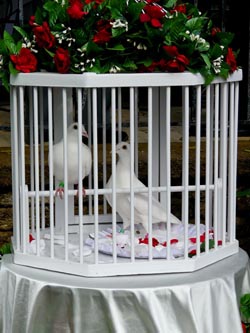
Birds teach us reverence—a virtue which, writes classicist and philosopher Paul Woodruff, “begins in a deep understanding of human limitations.” No beings show us our limitations better than do the birds. When we see a bird in flight or let our hearts soar on the notes of its song, the mystery of the world wells up before us—a mystery we long to embrace rather than conquer.
That day in the church, Rev. Bomford asked us to speak with her words fromTerry Tempest Williams’ book, Refuge.
“I pray to the birds,” we read, “because I believe they will carry the messages of my heart upward…”
Oh, yes, I thought. It was then the time of the fall migration, and with every overhead “V” I utter a prayer for the birds’ safe passage.
“I pray to the birds,” Williams continues, “because they remind me of what I love rather than what I fear…”
I thought back to my time with the emus. At first sight, I had fallen wildly, passionately, soul-splittingly in love. I had been working alone, collecting plant samples on a wombat preserve in the outback, when I looked up and saw them: three birds standing tall as a man, approaching me on their long, balletic, backward-bending legs—legs so strong they were capable of ending my life with a single kick. Instantly, I was smitten at once by their strangeness and familiarity. There was no room for fear. My heart was filled with awe.
Reading Terry Tempest Williams’ words, I gave thanks for all the many birds I have loved in my life: my parakeet Jerry; a cockatiel named Kokopelli who liked to sit on my head and whistle the National Geographic theme song when I was on the phone; my beloved Ladies. I did not know then, of course, that this book would bring me many more individual birds to love: the dancing cockatoo Snowball; Harris’s hawks named Jazz and Fire and Smoke; a talking African Grey parrot named Griffin; two orphaned baby hummingbirds who, God willing, could be raising babies of their own somewhere in California as I write these words right now.
“…And at the end of my prayers,” the few of us gathered in the church that morning read, along with the pastor, birds “teach me how to listen.”
This was my prayer as I began working on this book. It’s my hope that the birds you will meet in my new book will teach you, too.
